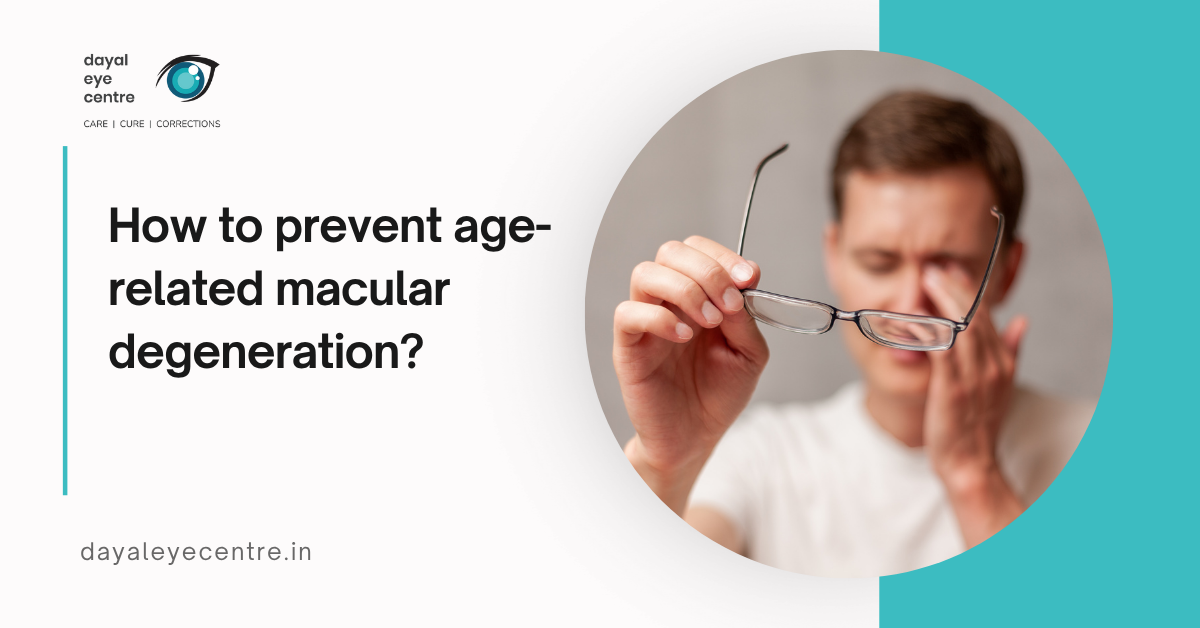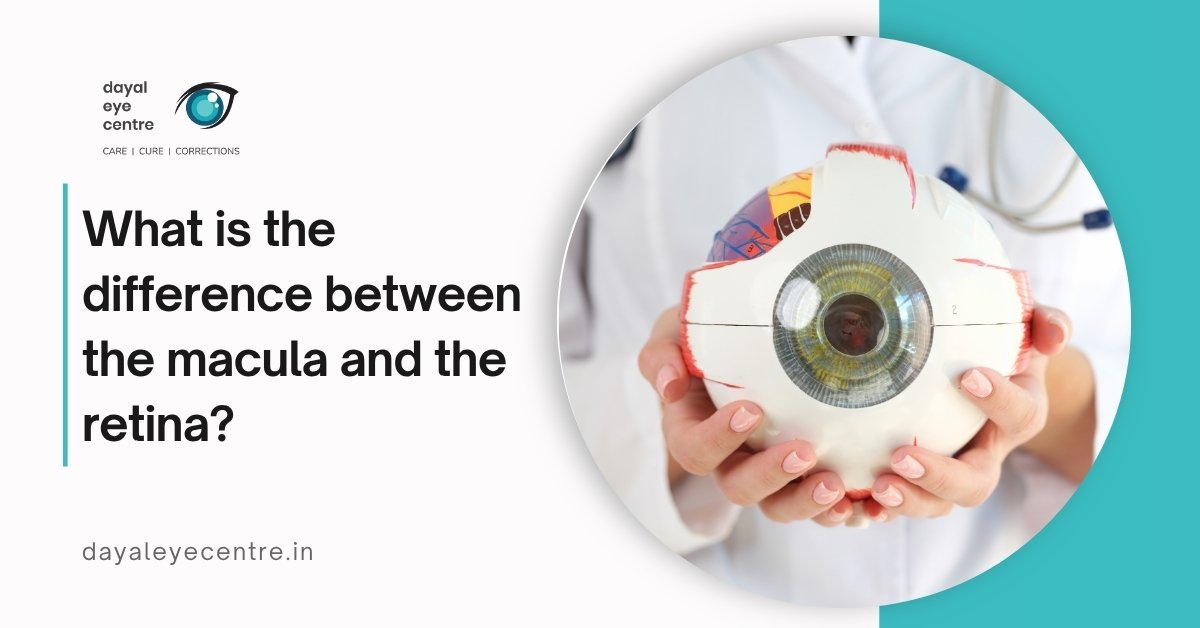Recognizing early retinal detachment symptoms can save your vision. These warning signs appear because your retina—the light-sensitive layer at the back of your eye—pulls away from its normal position. Like any other part of the body, your retina gives clear signals when something goes wrong.
Seeing new floaters suddenly
One of the most noticeable signs of retinal detachment is a sudden increase in eye floaters. Unlike the occasional floaters many people experience, these appear dramatically and all at once.
Floaters related to retinal detachment typically look like:
- Small dark specks or dots drifting across your vision
- Squiggly lines or cobweb-like shapes
- Strings of transparent bubbles or rods that follow your field of vision
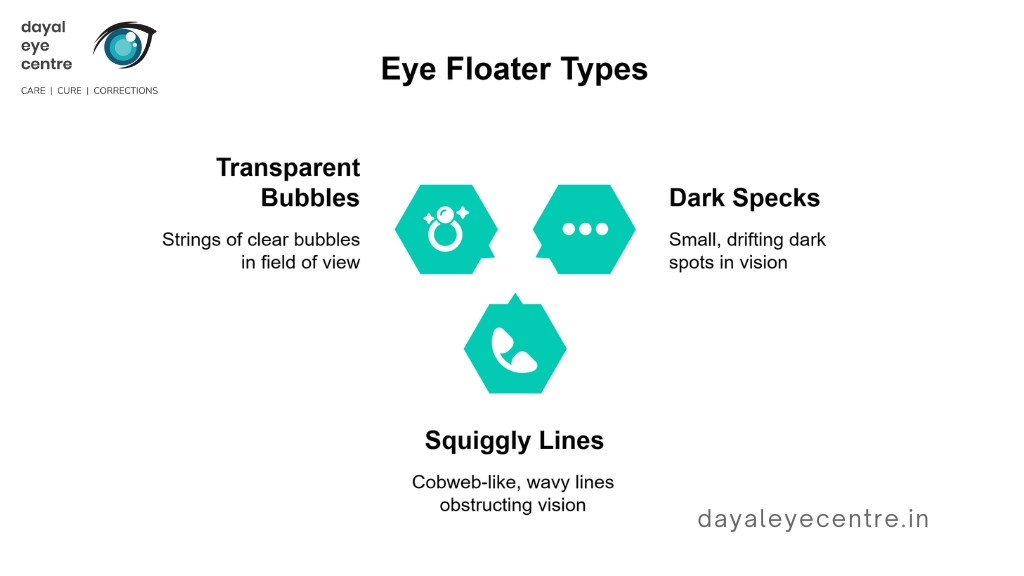
What makes these floaters concerning is their abrupt onset. While seeing a few floaters occasionally is normal, a sudden flood of new ones requires immediate attention. Sometimes, these floaters might even form a ring-like pattern near the temporal side of your central vision, which can be an early warning sign before complete detachment occurs.
Flashes of light in one or both eyes
Another telltale symptom is experiencing sudden flashes of light, also called photopsias. These brief flashes typically occur in your peripheral vision and may appear as:
Bright, lightning-like streaks that happen repeatedly within seconds or hours of each other. They’re often white or yellow in color and become more noticeable in darker environments.
Although flashes might affect one or both eyes, they’re unrelated to external light sources. In cases of posterior vitreous detachment, these flashes usually subside once the separation is complete and the vitreous tugging stops, though this may take several days.
Dark curtain or shadow moving across vision
Perhaps the most alarming detached retina symptom is the appearance of a shadow or curtain-like effect across your field of vision. This shadow typically begins in your peripheral vision and gradually spreads toward the center.
This curtain effect might descend from above, appear from below, or emerge from either side. Many describe it as a sensation of a transparent veil covering parts of their sight. You might notice darkening in your peripheral vision as this symptom progresses.
Unlike other eye conditions, retinal detachment is painless, making these visual symptoms your only warning signs. Take comfort knowing that with prompt treatment, about 90% of retinal detachments can be successfully repaired. If you experience any of these symptoms, particularly in combination, seek emergency medical attention immediately.
How symptoms progress over time
Like any other condition in the body, retinal detachment shows a clear pattern as it worsens. The severity of retinal detachment symptoms largely depends on how much of your retina has pulled away from its supporting tissue. How these symptoms progress often signals how quickly you need medical attention.
From mild floaters to severe vision loss
Your symptoms typically start subtly—perhaps just a few new floaters or occasional light flashes. As more of your retina detaches, symptoms intensify dramatically:
- Early stage: Sudden increase in floaters and light flashes
- Intermediate stage: Dark shadows appearing in peripheral vision
- Advanced stage: Curtain-like effect spreading toward central vision
- Final stage: Severe vision loss or blindness
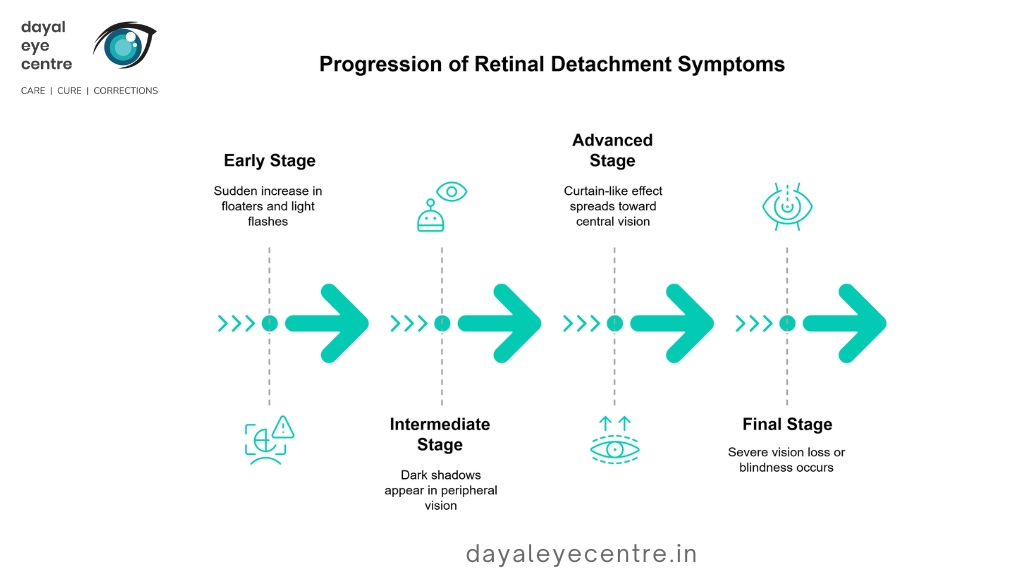
If a larger portion of your retina detaches, you’ll experience more pronounced symptoms. What begins as merely annoying floaters can rapidly deteriorate into serious vision impairment. The progression typically accelerates once the macula—responsible for central vision and visual accuracy—becomes involved.
Why symptoms can come and go
Some patients experience fluctuating retinal detachment signs and symptoms. During early stages, you might notice symptoms temporarily then find they seemingly improve.
This deceptive pattern occurs because:
- Small retinal tears may initially cause symptoms then stabilize
- Your brain temporarily adapts to visual disturbances
- The detachment may progress unevenly
Don’t be fooled by symptom fluctuations—they rarely indicate healing. Instead, they often mask continuing damage occurring without pain.
How long do retinal detachment symptoms last?
Without treatment, acute retinal detachment symptoms worsen rather than resolve. The numbers tell a concerning story: permanent blindness can develop as quickly as a few days after detachment begins.
The timeline varies based on:
- Location of detachment (macula involvement accelerates vision loss)
- Size of detached area
- Individual factors like age and eye health
Some sources suggest vision loss could occur within hours, while others indicate it takes several days. Regardless, retinal detachment represents a true eye emergency requiring immediate attention. The good news? With prompt treatment, surgery is highly successful—approximately 90% of cases achieve successful reattachment.
When symptoms mean an emergency
Every moment counts when dealing with acute retinal detachment symptoms. Your quick action could save your vision, while waiting might lead to permanent blindness.
Acute retinal detachment symptoms to watch for
Talk with your eye doctor immediately if you experience:
- Sudden appearance of many new floaters at once
- Flashing lights appearing unexpectedly in your vision
- A dark shadow or “curtain” moving across your field of view
- Peripheral vision loss or a gray curtain covering part of your sight
What makes these symptoms particularly concerning is their sudden onset and rapid progression. Like any other procedure in the body, your eyes send specific warning signals when in danger. Retinal detachment is painless, making these visual changes your only warning signs.
Why waiting can lead to permanent vision loss
Your retina needs constant blood supply and oxygen to function properly. Once detached, the tissue begins dying quickly. Vision loss can occur within hours of detachment in some cases.
The good news? Treatment works exceptionally well when caught early—approximately 9 out of 10 people achieve successful reattachment with prompt intervention. Delaying treatment significantly increases your risk of permanent vision damage or blindness.
The timeline is critical:
- Minutes to hours: Initial detachment occurs
- Hours to days: Progressive vision loss develops
- Days without treatment: Permanent damage becomes likely
Things to avoid with retinal detachment
If you notice symptoms or receive a diagnosis:
- Don’t wait and see if symptoms improve—even if they temporarily subside, the detachment is likely progressing
- Avoid rubbing your eyes or applying pressure, which can worsen the detachment
- Skip strenuous activities including heavy lifting or high-impact exercises
- Don’t drive yourself to emergency care—vision changes make this dangerous
- Avoid high-velocity activities post-recovery (skydiving, bungee jumping, contact sports)
After surgery, your doctor will provide specific positioning instructions—sometimes requiring you to keep your head in certain positions or even lie face down for several days. Following these guidelines carefully helps protect your investment in better vision.
Remember, your vision stability depends on how quickly you seek treatment. With retinal detachment, immediate medical care provides the best chance of saving your sight.
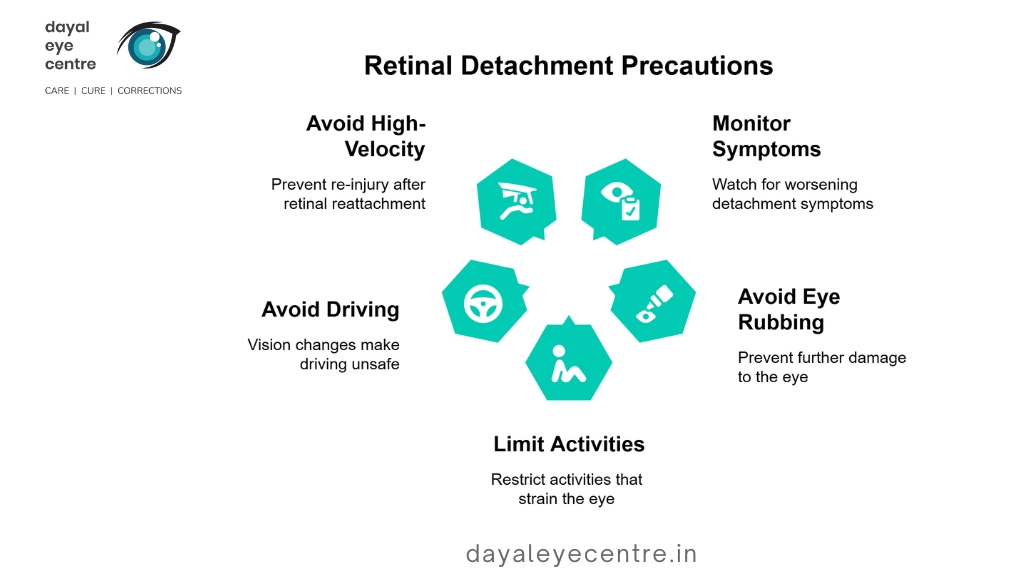
What happens after symptoms appear
Once you’ve spotted retinal detachment symptoms, prompt medical action becomes your next critical step. Like any other procedure in the body, treating retinal detachment requires proper diagnosis and specialized care to achieve the best results.
Getting diagnosed: what to expect
Your eye doctor will perform a dilated eye exam to examine your retina thoroughly. After placing special drops to widen your pupil, they’ll look for tears, holes, or areas where your retina has separated from the back of your eye. This examination is generally painless, though some patients find the pressure on their eyelids slightly uncomfortable.
If your doctor needs more detailed information, they might recommend:
- Optical coherence tomography (OCT) scan for detailed retina imaging
- Ultrasound if bleeding has occurred, making it difficult to see your retina
- Fundus imaging for wide-angle views of your retina
Talk with your eye doctor about what these tests show and what they mean for your treatment options.
Retinal detachment treatment options
For small tears before complete detachment occurs, your doctor might use:
Laser therapy or cryopexy – These procedures create scar tissue that seals tears and holds the retina in place. They’re typically performed in-office with minimal discomfort.
For actual detachment, surgical intervention becomes necessary. Treatment success rates reach approximately 90% when caught early. Your treatment options include:
Pneumatic retinopexy – Your surgeon injects a gas bubble into your eye to push the detached portion back into position, then uses laser or freezing to seal tears.
Scleral buckle – A small silicone band is sewn around your eye to gently push the wall toward your retina, helping reattachment.
Vitrectomy – This procedure involves removing the vitreous gel and replacing it with gas, air, or silicone oil to help flatten the retina.
The good news? These procedures have high success rates when performed promptly after symptoms appear.
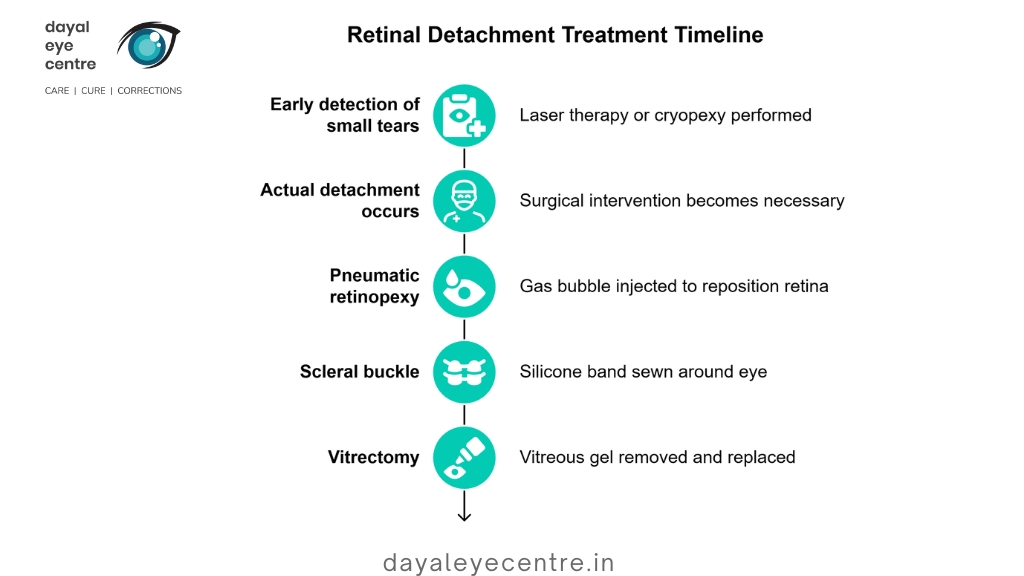
Surgery and recovery: what comes next
Immediately following surgery, your eye may feel sore and your vision will likely be blurry, similar to looking through a foggy window. At this point, specific positioning becomes crucial—especially if gas bubbles were used. You might need to:
- Keep your head in a particular position for up to 7 days
- Avoid certain activities like flying, heavy lifting, or strenuous exercise
- Use prescribed eye drops for up to 6 weeks
Full vision recovery typically takes 2-6 weeks, although complete retinal healing can take several months to a year. Regular check-ups with your eye doctor help monitor healing and address concerns promptly. If you experience severe pain or worsening symptoms, seek immediate medical attention.
Most patients see significant improvement in their vision, though the degree of recovery depends on how quickly treatment was received and how much of the retina was affected. Talk with your eye doctor about what to expect during your specific recovery process.
Conclusion
Recognizing retinal detachment symptoms quickly can save your vision. Like any other procedure in the body, early detection makes a critical difference in the outcome. Throughout this guide, we’ve explored how this serious eye condition shows itself through three distinct warning signs: sudden floaters, flashing lights, and curtain-like shadows moving across your field of view.
Time matters greatly with retinal detachment. What starts as a few floaters can quickly progress to permanent vision loss within days or even hours. Your awareness of these symptoms serves as your best protection against lasting damage. When these visual changes appear, seeking immediate care rather than “waiting to see” provides your best chance for vision preservation.
The good news? Treatment success rates reach about 90% when addressed promptly. Your eye doctor might recommend laser therapy for small tears or surgical options like pneumatic retinopexy, scleral buckle, or vitrectomy for complete detachment. Recovery typically takes 2-6 weeks for vision improvement, though full healing may require several months.
Vision preservation depends primarily on your quick action. Remember these three key warning signs:
- Sudden increase in floaters appearing all at once
- Flashes of light in your peripheral vision
- Dark shadows or curtain-like effect across your sight
Talk with your eye doctor immediately if you notice any of these changes. Your retina cannot heal itself once detached, but with proper treatment and aftercare, most patients regain significant vision. Studies show that patients who receive treatment within days of symptom onset have the best outcomes.
Take these warning signs seriously—your sight depends on recognizing them and acting quickly. Through proper care and immediate attention, you can protect one of your most precious senses.
FAQs
What are the primary symptoms of retinal detachment?
The main symptoms include a sudden increase in eye floaters, flashes of light in your vision, and a dark shadow or curtain-like effect moving across your field of view. These symptoms often appear suddenly and can progress rapidly.
How quickly should I seek medical attention if I experience retinal detachment symptoms
You should seek immediate medical attention if you experience any symptoms of retinal detachment. Prompt treatment is crucial, as vision loss can occur within hours or days of the detachment beginning.
Can retinal detachment be treated successfully?
Yes, retinal detachment can be treated successfully, especially when caught early. With prompt intervention, approximately 90% of cases achieve successful reattachment through various surgical procedures.
How long does it take to recover from retinal detachment surgery?
Full vision recovery typically takes 2-6 weeks, although complete retinal healing can take several months to a year. The recovery process may involve specific positioning requirements and activity restrictions.
Are there any warning signs before a full retinal detachment occurs?
Yes, there can be warning signs before a full detachment. These may include an increase in floaters, brief flashes of light, or changes in peripheral vision. If you notice these symptoms, it's important to have an eye examination promptly.




